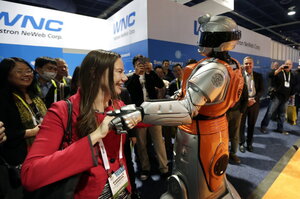Domestic robots invade CES 2015
The 2015 Consumer Electronics Show (CES) in Las Vegas offered a peek at a robot-filled future.

At CES in Las Vegas, Danielle London dances with a performer dressed as a robot at the Alibaba.com booth.
Jae C. Hong
At the 2015 Consumer Electronics Show (CES) in Las Vegas, more than a dozen companies unveiled different kinds of domestic robots. Some follow you around the house so you can continue a video call in different rooms. Another acts as a mobile air filter that tracks down airborne pollutants in the home.
But the real star of the show has been Furo-i Home. The mobile, cone-shaped bot attaches to a tablet, which displays a friendly android face. The Furo-i Home is equipped with sensors and can take direct, verbal commands from a user. For example, you can instruct the robot to adjust the temperature of a room or to turn on and off lights or music.
"The robot has many sensors, facial recognition, and can detect the temperature," Se-Kyong Song, chief executive of its maker, Futurebot, told the BBC.
Mr. Song says Furo-i can act as a tutoring aid for children and monitor family members. "You can set it to wake up an elderly parent, remind them to take their medicine, eat breakfast, and follow the rest of a schedule,” Song says. "And if something unexpected happens, it can send a message to the family saying there might be a problem and then let them talk to their parent via video chat to ask if they are OK."
Futurebot is hoping to sell at least 10,000 of the robots before the end of the year. They cost about $1,000 each.
Another notable domestic robot solves the problem of watering your yard. The Droplet is a sprinkler that uses an Internet-connection to adjust the amount water for individual plants in the surrounding area.
"We can accurately target two plants less than 6 [inches] away from each other and give them very different amounts of water," Steve Fernholz, the firm's founder, told the BBC. "And we take into account weather data, so if there's an 80% chance of a thunderstorm tonight it'll delay and wait to see if the rain actually falls."
Mr. Fernholz acknowledges that many people aren't ready to welcome robots into their daily lives. "It's not about when the technology is ready, it's when consumers feel comfortable enough about having a robot in their home. It's a very personal space,” he says. "That's why even with Droplet we tried to make it look inviting - not something you would feel apprehensive going up to or might give you anxiety."

